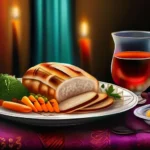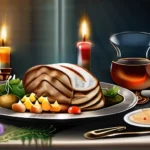Explore the intricacies of Kashrut and its significance in Judaism
Dive into the fascinating world of Jewish dietary laws, also known as Kashrut. This article will provide a comprehensive overview of these ancient traditions and their role in Jewish life.
The Foundations of Kashrut
How many times have you heard someone say, ‘Oh, we’re kosher,’ and wondered just what that means? Understanding Jewish dietary laws, known as Kashrut, is not only fascinating but also deeply significant in the practice of Judaism. These rules are rooted in the Torah and form a crucial part of religious observance for many Jews.
Imagine opening a window to peek into the ancient world, where you see people carefully preparing their meals according to these sacred instructions. Kashrut is like a guidebook that ensures every ingredient and preparation method aligns with divine law. But why go through all this trouble? Is it just about avoiding certain foods?
When we delve deeper, we find that the principles of Kashrut are much more than just dietary restrictions; they symbolize a way of life that seeks to honor God in every aspect of existence. For instance, eating only animals that have been deemed fit (such as cattle and sheep) involves checking for specific signs before slaughter. This process is not merely about meat but is akin to a ritual that signifies respect and reverence.
Moreover, the separation between dairy and meat, while complex, serves a profound spiritual purpose. It’s as if the kitchen becomes a sanctuary where two distinct worlds do not mix, just as God is seen as separate from His creation. This principle of keeping these foods apart in both diet and practice mirrors the separation between holiness and everyday life.
Understanding the foundations of Kashrut means embracing a tradition that has stood the test of time, guiding Jews to make choices that reflect their faith every single day. It’s like walking through a labyrinth with clear signs posted at every turn—each rule a reminder of divine commandments and values woven into the fabric of daily life.
Meat and Dairy: A Complex Relationship
Imagine a world where every meal isn’t just about sustenance but carries deep spiritual significance. That’s the essence of Kashrut, or Jewish dietary laws. One aspect that often puzzles newcomers is the complex relationship between meat and dairy products. Why can’t we mix them? Is it just a rule with no real reason behind it?
Delving into this question reveals a profound understanding of how Judaism views food and its role in religious practice. The prohibition against combining meat and dairy isn’t arbitrary; it’s rooted in the idea that each category should be treated separately, much like different aspects of life should have their own spaces and times.
- Why Meat and Dairy?
The Torah provides several reasons for this separation. One interpretation suggests it is a way to honor the animals by ensuring they are treated respectfully both before and after death, with meat representing life and dairy symbolizing nurturing. Another theory is that mixing these can lead to confusion about how foods were prepared, reinforcing the need for clear boundaries in religious observance.
But what’s fascinating is that beyond the literal interpretation, this law becomes a metaphor for managing different aspects of one’s life. Just as we wouldn’t mix our work and family time carelessly, separating meat from dairy teaches us to respect different domains and their unique roles.
This complex relationship between meat and dairy is just one piece of the intricate puzzle that makes up Kashrut. It challenges us to think deeply about how we integrate spirituality into every aspect of our lives, not just in prayer but also in what we eat.
The Role of Kosher Symbols
Imagine walking into a Jewish deli, the air filled with the aroma of freshly baked bread and the hum of bustling activity. As you peruse the menu, you might notice certain items marked with symbols like K, D, or P. These aren’t just decorative elements; they are a vital part of Jewish dietary laws known as kashrut. But what do these symbols mean and why are they so important?
The kosher symbol, often represented by the letter K, stands for Kosher, meaning that the food has been prepared according to Jewish law. This symbol is a reassurance that the product adheres to strict guidelines regarding cleanliness, preparation methods, and ingredients. It’s like having a personal seal of approval from a rabbi or kashrut agency, ensuring that everything on your plate is not only safe but also in harmony with Halacha, Jewish law.
The dairy symbol, denoted by the letter D, signifies that the product contains no meat and has been prepared according to kosher guidelines. This symbol is crucial for those who need to maintain a clear separation between milk and meat products, as these two categories are strictly prohibited from being eaten together in one meal. It’s like having a reminder that your plate needs to remain organized, with each category of food in its rightful place.
The P symbol is less common but still important; it stands for Pareve, meaning neutral or neither dairy nor meat. These products are free from both and can be eaten alongside either type of product. Think of them as the versatile players in a musical orchestra, fitting seamlessly into any part of your meal.
These symbols serve more than just informational purposes; they create a sense of community among observant Jews. When you see one of these symbols, it’s like recognizing a fellow traveler on the path to religious practice and understanding. They are not only about what you eat but also about the values and traditions that bind a community together.
So, next time you see these symbols on a menu or product label, take a moment to appreciate their significance. They represent more than just compliance with dietary laws; they are a symbol of commitment, tradition, and the deep cultural roots that shape Jewish life.
Fish and Fowl: The Permissible and Forbidden
Imagine you’re walking through a bustling market, surrounded by diverse stalls selling fresh produce and fish. In Judaism, each item has its place—some are kosher, while others are forbidden. This classification isn’t just about taste; it’s deeply rooted in the principles of Kashrut. Let’s dive into the world of fish and fowl to understand what makes them permissible or not.
First, consider the aquatic kingdom. Not all fish swim freely within these rules. For a fish to be considered kosher, it must have both fins and scales—like a trout. This means that fish without these characteristics are out of bounds. A common example is shellfish, such as clams or lobsters, which are forbidden because they lack the required features.
Now, let’s turn to the skies. When it comes to fowl, the rules get a bit more complex. The Torah lists specific birds that are not kosher, like vultures and eagles. For a bird to be acceptable, it must have a crop (a muscular pouch for storing food) and the ability to chew its cud—a sign of being a true ruminant. Chickens and ducks, however, are permissible because they fit these criteria.
The reasoning behind these classifications? Many believe that the Torah aims to promote health and hygiene. By specifying certain traits, Judaism ensures that certain foods are avoided, reducing the risk of disease from harmful bacteria or parasites.
But it’s not just about health; there’s a deeper spiritual significance too. Kosher laws serve as a reminder of God’s commandments and help Jews maintain their cultural identity and religious practices in daily life. Every bite is a choice that connects them to their heritage, reinforcing the values of purity and sanctity.
The Preparation of Kosher Food
Imagine preparing a meal as a sacred ritual, where each step—from the moment you lay eyes on your ingredients to the final plating—is imbued with spiritual significance. In the intricate world of Kashrut, or Jewish dietary laws, every detail is crucial in ensuring that food is prepared in accordance with divine commandments.
When it comes to slaughtering animals for kosher meat, one must employ a precise method known as shechita. This involves a swift, clean cut made by an expert slaughterer using a shochet, a specially trained individual. The goal is not just to end life but to do so in the most humane and quick manner possible, ensuring minimal suffering for the animal. It’s like performing a delicate dance where every move has been choreographed to perfection.
After slaughtering, the next step is salting, which serves both practical and ritual purposes. The salt draws out blood from the meat, making it safe to eat, as blood is considered unclean in Jewish tradition. Think of this process as a cleanse, not just for the physical body but also for the soul. The shochet uses a mixture of salt and water, spreading it evenly over the meat before allowing it to drain. This step is crucial, as any residue could render the meat non-kosher.
The third critical process in preparing kosher food is boiling. Certain parts of an animal, such as the giblets, must be thoroughly cooked or boiled to remove any remaining blood. It’s like a final purifying bath, ensuring that no impurities remain before consumption. This step is often seen as a metaphor for cleansing one’s life, much like how boiling water can clear away dirt and grime.
Each of these steps—shechita, salting, and boiling—is more than just a series of actions; they are rituals that connect us to the divine in every bite. By adhering to these stringent practices, Jews ensure that their food is not only safe but also spiritually pure. These methods reflect a deep respect for life and a commitment to living in harmony with God’s commandments.
The Impact of Kashrut on Jewish Life
The Impact of Kashrut on Jewish Life: Investigate how Jewish dietary laws shape daily life, social interactions, and the Jewish community as a whole.
Imagine stepping into a bustling synagogue where the air is thick with the anticipation of a communal meal. The hum of conversations gradually fades as people turn their attention to the table, each piece of food meticulously prepared according to Kashrut. This ritual is more than just a set of rules—it’s a thread that weaves through every aspect of Jewish life, from early morning prayers to late-night study sessions.
How does Kashrut impact daily routines? Consider the morning meal. A quick glance at what’s being prepared reveals a world governed by specific guidelines. Bread must be made without yeast, ensuring it’s unleavened (matzah). This simple rule not only affects food choices but also reflects the deep connection between dietary laws and holy days. It reminds Jews of their history and the traditions that have been passed down for generations.
Social interactions are transformed by these practices. Sharing a meal with friends or family isn’t just about eating; it’s an act of unity, respect, and adherence to tradition. Every time we sit down to eat, we recommit ourselves to our faith and community. The shared experience of following these rules strengthens bonds and reinforces cultural identity.
Moreover, Kashrut plays a significant role in the broader Jewish community. It acts as a bridge between individuals, fostering a sense of unity and belonging. Even those who may not fully understand or follow all the laws can appreciate the effort and respect shown towards them. This shared observance becomes a unifying factor, reminding everyone that we are part of a larger family with common values.
As we delve deeper into these practices, it’s clear that Kashrut is more than just about what goes into our mouths. It’s a lived experience that shapes our lives in profound ways. By exploring and embracing these traditions, we not only honor our heritage but also enrich our personal and communal journeys.
Conclusion
 By the end of this article, you’ll have a deeper understanding of Jewish dietary laws and their importance in Judaism. Remember, respect for these traditions is key to appreciating the richness of Jewish culture.
By the end of this article, you’ll have a deeper understanding of Jewish dietary laws and their importance in Judaism. Remember, respect for these traditions is key to appreciating the richness of Jewish culture.











